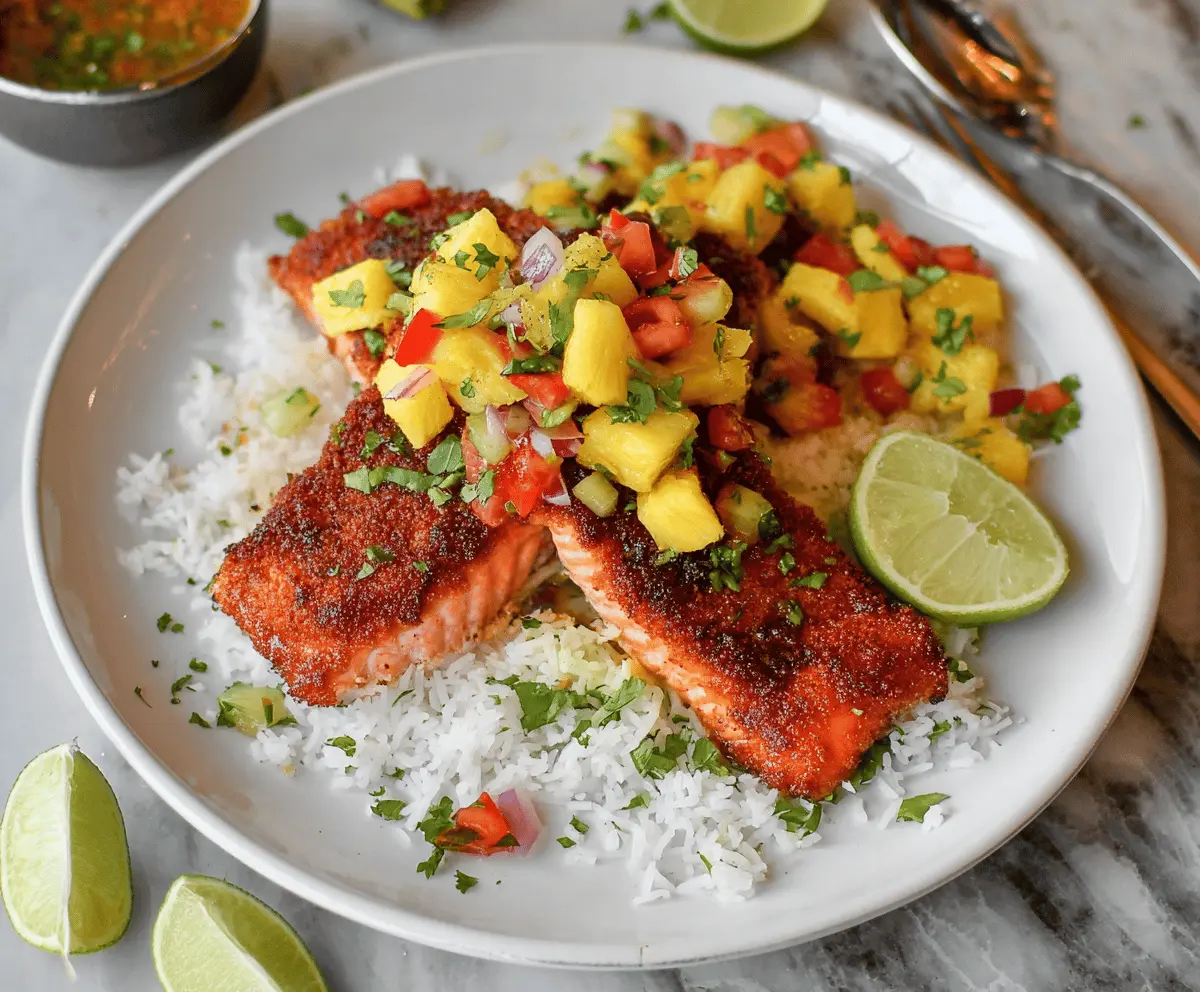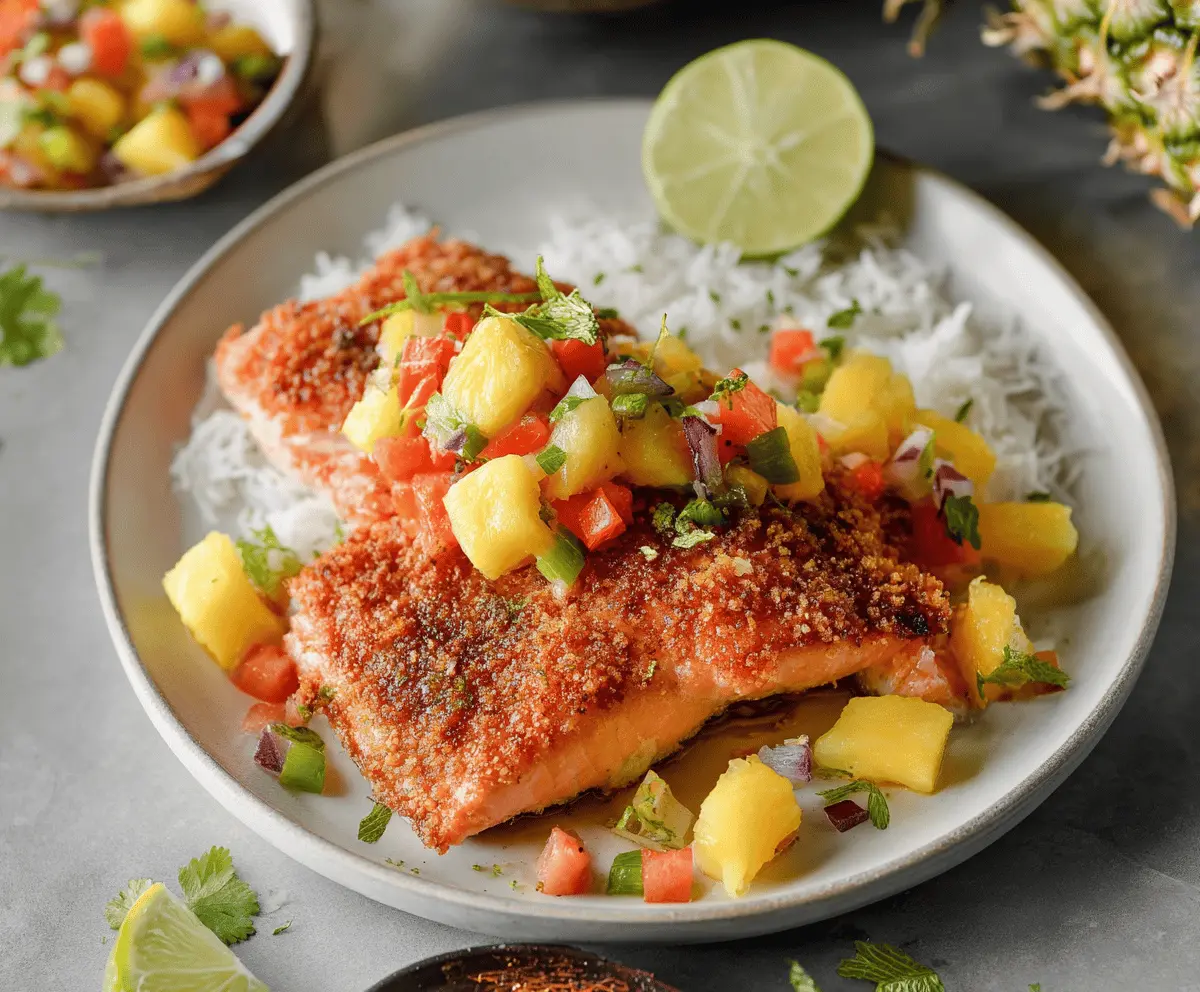This salmon dish is a tasty mix of flaky fish coated in crunchy coconut, and it gets a refreshing boost from sweet pineapple salsa. It’s like a mini vacation on your plate!
I love how the flavors come together with each bite—salty, sweet, and a touch tropical! Serve it with rice or a salad for a fun dinner. You’ll feel like a chef in a beachside restaurant! 🌴
Key Ingredients & Substitutions
Salmon: Look for fresh fillets without skin for best results. If salmon isn’t available, you can substitute with trout or tilapia, which also holds up well with the coconut crust.
Coconut: Unsweetened shredded coconut gives the best flavor. If you can’t find it, sweetened coconut can work, but your dish will be sweeter. Toasting it a little first enhances its nutty flavor!
Panko Breadcrumbs: These add extra crunch, but you can use regular breadcrumbs if needed. Just be aware they may not be as crispy. Gluten-free breadcrumbs are a great option too!
Smoked Paprika: This provides a warm, smoky flavor. If you want a milder taste, swap it for regular paprika or cayenne for some heat.
Pineapple: Fresh pineapple is ideal for its juiciness and sweetness, but canned pineapple works in a pinch. Just make sure to drain it well.
How Do I Get the Perfect Coconut Crust on Salmon?
Achieving a crispy crust on your salmon is all about the right technique! Here are some steps that help:
- Make sure your salmon fillets are dry. Pat them with paper towels to ensure a good coat sticks.
- First, dip the fillets in beaten eggs to help the crust adhere. Then, firmly press each fillet into the coconut-panko mixture.
- Drizzling oil over the fillets adds flavor and promotes browning, creating that crunchy texture you’re after!
- Keep an eye on them in the oven. They usually take 12-15 minutes, but check if the crust is golden and the salmon flakes easily with a fork.
With these tips, you’ll have beautifully crusted coconut salmon that’s not just delicious but eye-catching too!

Tropical Coconut Crusted Salmon With Pineapple Salsa
Ingredients You’ll Need:
For the Salmon:
- 4 salmon fillets (6 oz each), skin removed
- 1/2 cup shredded unsweetened coconut
- 1/2 cup panko breadcrumbs
- 1 tsp smoked paprika
- 1/2 tsp salt
- 1/4 tsp black pepper
- 2 eggs, beaten
- 2 tbsp olive oil or coconut oil
- 1 cup cooked jasmine rice (for serving)
For the Pineapple Salsa:
- 1 cup fresh pineapple, diced
- 1/2 cup tomato, diced
- 1/4 cup red onion, finely chopped
- 1 small jalapeño, seeded and minced (optional for heat)
- 2 tbsp fresh cilantro, chopped
- Juice of 1 lime
- Salt to taste
How Much Time Will You Need?
This delicious dish takes about 15 minutes for prep and around 15 minutes to bake, totaling about 30 minutes. The pineapple salsa can be prepared while the salmon is in the oven, making this a quick and easy meal to whip up!
Step-by-Step Instructions:
1. Preheat the Oven:
Start by preheating your oven to 400°F (200°C). This is the perfect temperature for getting those salmon fillets nice and crispy. Line a baking sheet with parchment paper, or you can lightly grease it to keep the salmon from sticking.
2. Prepare the Coconut Crust:
In a shallow dish, mix together the shredded coconut, panko breadcrumbs, smoked paprika, salt, and black pepper. This mixture will give the salmon a delicious crunch and flavor.
3. Beat the Eggs:
In another shallow bowl, beat the eggs until they’re well mixed. This will help the coconut crust stick to the salmon.
4. Coat the Salmon:
Take each salmon fillet and pat them dry with paper towels. Then, dip each fillet into the beaten eggs, making sure to coat it well. After that, press the fillet into the coconut-panko mixture, covering both sides entirely. Place the coated fillets on your prepared baking sheet.
5. Add Oil:
Drizzle the olive oil or coconut oil over the coated salmon fillets. This helps them get crispy while baking and adds extra flavor.
6. Bake:
Now, pop the baking sheet into the oven and bake for about 12-15 minutes. You want the salmon to cook through and the crust to turn golden brown—yum!
7. Prepare the Pineapple Salsa:
While your salmon is baking, it’s the perfect time to whip up the pineapple salsa. In a mixing bowl, combine the diced pineapple, diced tomato, finely chopped red onion, minced jalapeño (if using), cilantro, lime juice, and a sprinkle of salt. Gently toss everything together and adjust any seasonings to your taste.
8. Serve:
When the salmon is ready, take it out of the oven. On each plate, place a portion of cooked jasmine rice, lay on a coconut crusted salmon fillet, and generously spoon pineapple salsa over the top. It looks and smells amazing!
9. Garnish and Enjoy:
If you’d like, add a few fresh cilantro leaves or lime wedges for garnish. Now, you’re all set to enjoy your tropical feast—it’s delicious, healthy, and sure to impress!
Can I Use Fresh Salmon Fillets Instead of Frozen?
Absolutely! Fresh salmon fillets are great for this recipe. Just make sure you pat them dry well before coating them for the best crust. If you only have frozen salmon, make sure to fully thaw it in the refrigerator overnight or under cold water before cooking.
Can I Make the Pineapple Salsa Ahead of Time?
Yes! You can prepare the pineapple salsa a few hours in advance. Just store it in an airtight container in the fridge. This allows the flavors to meld nicely, but you may want to add a splash of lime juice right before serving for freshness!
How Do I Store Leftovers?
Store any leftover salmon and pineapple salsa in separate airtight containers in the refrigerator. The salmon is best consumed within 2 days, while the salsa can last up to 3 days. To reheat the salmon, do so gently in the oven or microwave to avoid drying it out.
Can I Substitute the Salmon with Another Fish?
Yes, feel free to substitute the salmon with another white fish like tilapia or cod. Just keep in mind that cooking times may vary based on the thickness of the fish fillets, so adjust accordingly!



